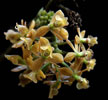|
|
|
|
|
| |
Flasks of
Epidendrum anceps 'Red' × 'Halcyon' |
|
| |
|
|
| |
|
|
Click to Enlarge

Pod Parent Flowers (direct scan) |
Click to Enlarge

Pollen Parent Flowers |
|
|
|
| |
Culture Notes from Donor: Does well mounted, and will accept temperatures from warm to cool.
Pod parent plant: Temperature range W (70-90°F)
Pollen parent plant: Temperature range I (60-83°F)
Comments: Has drooping racemes of small flowers, reblooms from old spikes and therefore is continuously in bloom from leads of all ages. Plant is upright to 40" (1m) in height and is widespread from Florida to northern South America.
Pod parent plant: This cultivar is red with a purple lip.
For additional origin/habitat information supplied courtesy of
Charles and Margaret Baker, see further below, near the bottom of this page.
|
Temperatures we attempt to use in the lab & greenhouse:
| For Species: |
|
Spring, Summer, Autumn, Winter: days average 77°F, nights 60°F; best fit is Cool-Intermediate 75-58°F
(Source:
Baker's Web OSC) |
|
About the name...
| Etymology of |
anceps |
|
From Latin "anceps" two headed, two sided, two edged, double.
(Source:
Brown 1956) |
| Etymology of |
Epidendrum |
|
From Greek "epi" upon; "dendron" tree.
(Source:
Pridgeon 1992) |
| Pronunciation of |
anceps |
|
AN-seps
(Source:
Hawkes 1978) |
| Pronunciation of |
Epidendrum |
|
eh-pee-DEN-drum
(Source:
Pridgeon 1992) |
|
If you would like to direct someone to this web page, please copy and paste this URL into your email:
http://troymeyers.com/d?012503
| Flask Information |
| Availability: |
We have sold all of the flasks for this item. |
| You should: |
Consider getting individual plants or compots instead of a flask.
You can place a "Notify Flask Recipients" Request, and either we or a flask recipient may contact you when plants are available.
You may also place a "Notify Retries" Request, and if an identical pollination (the same parents) is done again, we'll let you know.
You may reserve a flask, but it's very unlikely you'll get one ...this could only happen if we found a flask that we didn't know we had. |
| Yield Estimate: |
270 plants (based on flask surveys done 09/17/2002 )
|
| Plantlet Sizes: |
From many flasks 30 - 55 mm plants (based on flask surveys done 05/13/2003 )
From one most recently surveyed flask 30 - 55 mm (05/13/2003)
|
|
You might also want to:
|
View the seed assay for this item.
View items of the same species.
View items of the same genus.
|
| Ordering Information |
| You are not currently logged in. |
|
You must be a registered user and be logged in to reserve a flask or place a notification request. Please log in:
|
|
|
|
|
|
| |
The origin/habitat information below is supplied courtesy of Charles and Margaret Baker
The following information is based on the name of the plant provided by the donor, and assumes that the name is correct. If the plant has been misidentified, then the following information may not be correct.
This text is copyrighted by the Bakers and may not be reproduced without permission.
ORIGIN/HABITAT: As currently accepted by many taxonomists, this species is
widespread from Florida, the West Indies, Mexico, throughout Central
America, Colombia, Venezuela, the Guianas, Peru, Ecuador, and Brazil.
Plants grow epiphytically in damp forests at elevations between sea level
and 6550 ft. (0-2000 m). In most areas, however, they are most often found
at 1650-3950 ft. (500-1200 m). In Mexico, plants are found in the states
of Veracruz and Chiapas, but details of habitat location and elevation
were not reported. In Belize, plants are reported as E. secundum have been
found but are uncommon in the Orange Walk and Cayo Districts, including
the Mountain Pine Ridge Reserve. In Guatemala, plants have been collected
on both the Pacific and Caribbean watersheds in the Departments of Alta
Verapaz, Izabal, and Suchitepequez. Collections are widespread through
Honduras and Nicaragua, but they are usually made on the Caribbean
watershed at 650-1650 ft. (200-500 m). In Costa Rica and Panama, plants
have are recorded in lowlands on both coasts usually below 3300 ft. (1000
m). In Venezuela, plants are found on coffee shade trees at about 3000 ft.
(910 m) near Caripe in the coastal mountains east of Barcelona and at
about 4000 ft. (1220 m) above Caucaguita, which is near Caracas. In
Surinam (Dutch Guiana), plants (reported as E. secundum) are found in
moderately moist forests and along streams in both the coastal lowlands
and higher inland regions. In Ecuador, plants have been collected at
numerous locations on the western slopes of the Andes growing in tropical
wet and mountain cloudforest at 250-2150 ft. (80-650 m). In Peru, plants
have been collected near Tarma and San Ramon in the Department of Junin at
2200-4600 ft. (670-1400 m). This species is widespread throughout the
islands of the Caribbean. Plants are found in many areas in Cuba and
Jamaica. In Puerto Rico, they are widespread throughout the island,
particularly the west and north coasts and the western interior. They grow
in moist or wet forests at 350-2800 ft. (100-850 m). Plants have also been
found on St. John, St. Thomas, and Virgin Gorda in the Virgin Islands and
other Carribean islands including St. Martin, Antigua, Saba, St.
Eustatius, Quills, St. Kitts, Guadeloupe, Dominica, St. Lucia, St.
Vincent, Barbados, and Grenada in the Lesser Antilles. Habitat details on
these islands were not reported. In Florida, Luer (1972) reported that
this species is widespread throughout the forests and hammocks of the Big
Cypress Swamp and the Everglades. The type specimen was collected on
Martinique
More about this information and the Bakers...
|
|
|
| |
|
|
|